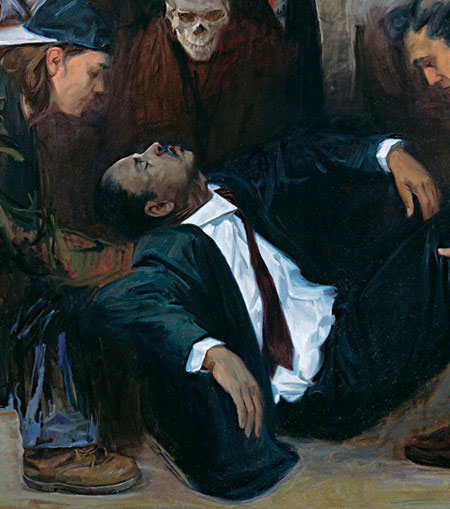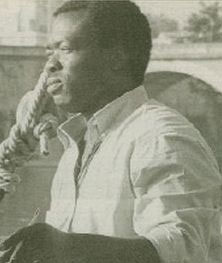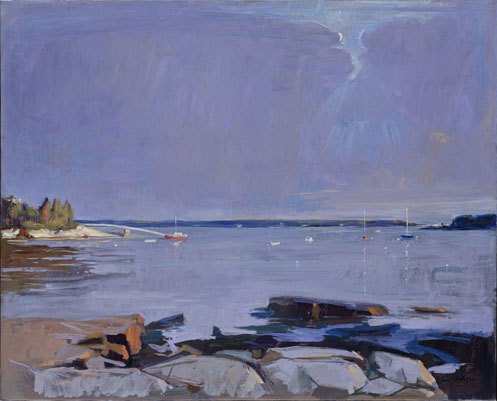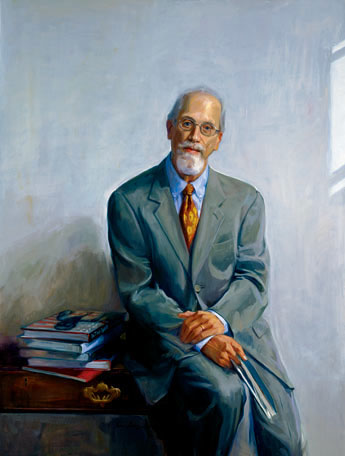Dear Artist,
On a boat there can be a cargo of wisdom. I’ve brought along some marvelous books. Samuel Adoquei’s
How Successful Artists Study is an up-to-date, practical guide for the transition from art school to the professional world of art. In it he talks about the “Five worlds of artists”:

“The Legacy and Burial of Martin Luther King”
oil on canvas, 68 x 68 inches
by Sam Adoquei
1. The inner, personal world.
2. The real and practical world.
3. The outside, commercial world.
4. The future, aspiring world
5. The fantasy world of dreams.
Adoquei suggests budding artists need to get their worlds separated from one another. Mixing fantasy with practicality is a leaky proposition. Funnily, the condition is as common as art school graduates who make their living doing anything but art.

Sam Adoquei
There is also a past world, a present world, and a future world. A highly literate artist with glowing optimism for the future is dead in the water if she’s not seeing her present world with clarity. She may have to buckle down and improve her work. She may have to make sacrifices. She may have to rethink her vision. She may have to reinvent her education. Her predicament may be further confused by the seemingly charmed life she likes to project. She may need to learn that the really charmed life is earned, and, according to Adoquei, it may not always be charming.

“Maine”
oil on canvas
by Sam Adoquei
The charmed life is earned by attitude. Thriving artists remain curious, experimental, joyful, self-critical and driven by a state of perpetual studenthood. Work takes pride of place and is well above talk. Art is self-anointing, mainly self-taught and independent. Our profession calls for the ego force that keeps our sense of uniqueness in ship-shape condition. Perhaps there is no other way. Successful artists live in their own worlds.
A small ship brings out an independent creative spirit. Provisioned and fueled, we have reserves for a lengthy tour and ongoing self-sufficiency. A ship, like an artist, is her own world. Each day brings new horizons and navigational challenges. The human spirit needs to sail on its own terms.

“Gary Chassman”
oil on canvas, 44 x 54 inches
by Sam Adoquei
Best regards,
Robert
PS: “Combine all your healthy wishes, dreams and hopes into investing in your talent and in the acquisition of knowledge and wisdom. If your art contributes to society, or to the art enthusiasts around you, then you are rewarded honestly, and more so if you make yourself useful to the world around you.” (
Samuel Adoquei)
Esoterica: When you start to see your art as a service to others, and you begin to believe in the societal aspects of it, you begin to thrive. It is a benefit for others to invest in the character you have nurtured and developed. Your world can be larger than the worlds of others, because you exact standards from yourself that others may not reach for or care to grasp. Our world is a privilege, an opportunity and an obligation.
The perils of education
by Haim Mizrahi, East Hampton, NY, USA

“181”
original painting
by Haim Mizrahi
You should have started the letter with
The human spirit needs to sail on its own terms. All the artists who are unfortunate to go through any of the arts establishments and, or, institutions as a way of getting themselves acquainted with the actual world of painting and creativity need to spend most of their lives to wash off the garbage that was bestowed upon them. There is only one world, in my opinion, through which an artist, any artist, stands a decent chance to have his or her voice heard, and it is the world of intimacy that one spends as much time in the studio as possible. Past, present and future, I do not know what that means other than question marks added to the many that already exist.
There is 1 comment for
The perils of education by Haim Mizrahi
Am I supposed to change?
by Maritza Bermudez, Wheaton, IL, USA

“Banana Leaves”
watercolour painting, 22 x 15 inches
by Maritza Bermudez
In other words, if you start to see your art as a service to others you may be creating for society or for what society likes at a certain time, depending of what’s in or out and not creating what you like to do which can be completely different to what society likes. So, let’s say I’m a nature artist but society is into abstracts, am I supposed to change and start producing paintings of abstracts, even if I don’t enjoy doing it just to please society and to try to sell my art? I see a commercial artist as one who creates art to sell, as I see a creative artist as one who sells what he creates. That’s my artist world.
(RG note) Thanks, Maritza. It’s easy to be jaded and blame fickle fashion for not picking up on your genius. I don’t think it’s a matter of changing. I think it’s a matter of getting even better at what you love the most. There is some solace in the thought that the great wildlife painters have not yet been born, nor have the great abstractionists. They will be noticed when they are.
There are 3 comments for
Am I supposed to change? by Maritza Bermudez
Ego force lets her down
by Asta Dale, Calgary, AB, Canada
I have been struggling all through life to recognize the different levels of ‘worlds’ and adjust to them. Not an easy task! It is often full of ‘pitfalls’ that require a restart and a different approach!
You talk about ‘seeing your art as a service to others,’ and I agree with that. To my mind ‘Art’ is teaching us to see the world as it is — very complex — related — unique — wonderfully magical — and very challenging to understand. I believe that only a small number of people agree with my vision, if you happen to believe in abstraction, like I do. Consequently, the rewards are also limited or — perhaps — my vision, or representation of vision to others is not very clear — this in itself is always my question and constant challenge. I also realize that art is a kind of communication which is not always understood by the ‘uninitiated’ — hence — artist’s talks help overcome that. Artist talks may clarify a subject matter, but if you concentrate on a broader vision, there is a danger of getting lost in misunderstandings. How to overcome this dilemma? It is my profound belief that the artist has to be true to ‘her/his — self’ and I try to work this way. But my ego-force sometimes lets me down.
There is 1 comment for
Ego force lets her down by Asta Dale
What keeps her young
by Mabel Gawne

“Okanagan Sage with Giants Head”
original painting
by Mabel Gawne
Your letters are always a learning experience, and have given me a broader view of what is forming in the minds of other painters. You are actually a painter with your written words! You have encouraged myself and thousands of other painters to explore our own style to the fullest. At the moment I am in love with orange poppies, with dark green foliage. I have blown them up, so that the poppies are a foot across. The canvases are a foot and half across, by three foot long! So I have done three panels. One lengthwise, one horizontal, the third lengthwise — (maybe, with orange cushions on the couch?) All this is exciting to a 93 year old, but this is what keeps me young !
There are 4 comments for
What keeps her young by Mabel Gawne
Why I am here
by Julie Wiegand

Untitled
oil painting
by Julie Wiegand
It’s a quiet Sunday morning here in rural Missouri — not my usual time to check my mail — but today I needed to — and decided I would read your letter. An Artists World put me in a more positive and grateful place. I have been a professional artist (oil paintings and murals) for more than 30 years — and although my efforts in growing my work have not always been what they could be, I have made slow steady progress at becoming a developed artist. I have always made money — some years much more than others and the last year and a half has been less than stellar as far as my economy — so that has been wearing on my spirit. Your words within esoterica made my heart sing and brought tears of joy. Thanks for reminding me why I am here!
There is 1 comment for
Why I am here by Julie Wiegand
Broken masterpieces
by Alex Nodopaka, Lake Forest, CA, USA

“Caress 20”
bronze sculpture
by Alex Nodopaka
Your letter oozes and dribbles and spatters a rainbow of philosophical hues on the necessary realization that when squeezed not every tube of paint produces a complete masterpiece. Sometimes the remnants of paint produce only a fraction of one and we must be content with it. I’m into making a series of artwork named “Broken Masterpieces.” They are of anything that shatters on the ceramic flooring and I consider if an armless antique is priceless, so are my dishes.
Finding ways to serve
by Bill Hibberd, Summerland, BC, Canada

“June 30”
original painting by Bill Hibberd
Sam Adoquei’s comments are very relevant. My first two years of serious consistent painting would be described as obsessive and self involved. Every choice was determined by how it would contribute to my artistic progress. Studio time took precedence over alternative activity. Two years in I’m noticing opportunities to serve others through technical suggestions, encouragement through example, or direct charity. If I can progress maybe someday my work will speak into people’s lives and the paintings themselves will become the servants, just as Sam’s are.
(RG note) Thanks, Bill. Several artists wrote to ask where Samuel Adoquei’s book could be bought. The Amazon address is
here.
Why do schools exist?
by David Kemp, Nelson, New Zealand

“Tarakohe”
oil painting
by David Kemp
As a self-employed very uncommercial but survivor artist for the last 20 years, I can relate to the points from the book which you comment upon. The points are very important, as so many people who are into Art and go to art school and are indoctrinated in the current philosophies of what art is about and getting the grades needed to pass through the course, but have very little understanding of survival after the course, that it could be argued that art schools exist for the benefit of the tutors as much as they advocate art. I term myself a ‘blokey expressionist’ (bloke here is a common man) although I have a varied expressive arts background.
There is 1 comment for
Why do schools exist? by David Kemp
‘The crazy ones’
by Sarah Garland, Canada
Steve Jobs, Apple C.E.O. —
“Here’s to the crazy ones.
The misfits.
The rebels.
The troublemakers.
The round pegs in the square holes.
The ones who see things differently.
They’re not fond of rules.
And they have no respect for the status quo.
You can praise them, disagree with them, quote them, disbelieve them, glorify or vilify them.
About the only thing you can’t do is ignore them.
Because they change things.
They invent. They imagine. They heal.
They explore. They create. They inspire.
They push the human race forward.
Maybe they have to be crazy.
How else can you stare at an empty canvas and see a work of art?
Or sit in silence and hear a song that’s never been written?
Or gaze at a red planet and see a laboratory on wheels?
We make tools for these kinds of people.
While some see them as the crazy ones, we see genius.
Because the people who are crazy enough to think they can change the world, are the ones who do.”
There is 1 comment for
‘The crazy ones’ by Sarah Garland
No miracle here
by David Pearkes, Manchester, UK
I am not a painter. But I marvel at the variety and fairness of your approaches, Robert, and how you can be in so many places at once, both mentally and physically, and how in a subtle and humble way, you exude such curiosity. Is this something characteristic of all artists, do you think, or is it unique to you?”
(RG note) Thanks, David. I know lots of creative folks who live far more exciting and evolved lives than myself. Perhaps the sort of thing you mention comes in degree with the territory. To be fair, though, I think some of it has to do with knowing you deserve your life to be charmed. In this sense, artists get away with murder. And it’s not at all neat. A few years ago some grade four students who had been to visit me were asked by their teacher to send along a finished sentence that started out with “What I liked most about Mr. Genn’s studio was…” One astute kid wrote, “…He has somebody else clean up after him.”
[fbcomments url=”http://clicks.robertgenn.com/artists-world.php”]
Featured Workshop: Bruce Peil
 Bruce Peil Workshops
The Workshop Calendar provides up-to-date selected workshops and seminars arranged in chronological order.
Bruce Peil Workshops
The Workshop Calendar provides up-to-date selected workshops and seminars arranged in chronological order. |

|
Featured Artist: Yuqi Wang
|

Year of the dog
oil painting
by Yuqi Wang, New York, NY, USA
|
>You may be interested to know that artists from every state in the USA, every province in Canada, and at least 115 countries worldwide have visited these pages since January 1, 2013.
That includes Andrea Chand of Felixstowe, UK, who wrote, “It is indeed a wonderful world if we could only let it be.”
And also Jeffrey Peterson of Nashville, TN, USA, who wrote, “‘The unexamined life is not worth living.’ (
Plato)”
And also Catherine Surtees of Hawaii who wrote, “I love the book
Twice-Weekly Letters. It is informative, funny, inspiring, and poetic. I love the fact that one can pick it up and read it at any time and get something great from it.
Mahalo nui loa.”


















Bravo!